
|
PDS have extensive experience in the FEA / CFD / FSI analysis of Brush Seal Designs. The analyses can include: · Full 3D body-to-body contact with friction, pressure stiffening and rotor interference. This includes Bristle-to-Bristle, Rotor to Bristle tips and Bristles to backplate contact · Precise geometric modelling including to model Axial Pressure / Blowdown · Heat generation due to frictional contact and consequential Thermal-Mechanical effects · Fluid flow analysis using ADINA CFD. Models include full Navier-Stokes flow, Turbulent flow, Thermal effects, Compressible flows and Darcy-Forchheimer porous flows · Fully coupled Fluid Structure Interaction with ADINA’s CFD module including Porous FSI with Thermal effects included · Circumferential modelling of the bristle pack.
Relevant Papers 1) Title: Brush Seal Hysteresis AIAA 2012-4003; July 2012 (48th AIAA/ASME/SAE/ASEE Joint Propulsion Conference & Exhibit)
2) Title: Bristle Angle Effects on Brush Seal Contact Pressures AIAA 2009-5168; Aug 2009 (45th AIAA/ASME/SAE/ASEE Joint Propulsion Conference & Exhibit ) |
|
The left hand FEA plot shows the brush seal bristle pack with the splay / flare between adjacent bristle visible.
The right FEA hand plot showing the initial splay of this brush seal design. |
|
The left hand FEA plot shows the brush seal bristle pack thickening effect as a result of 0.025” rotor interference.
The right hand FEA plot shows the result of the 0.025” rotor interference from a different viewpoint. Here the original position of the bristle pack is also shown. |
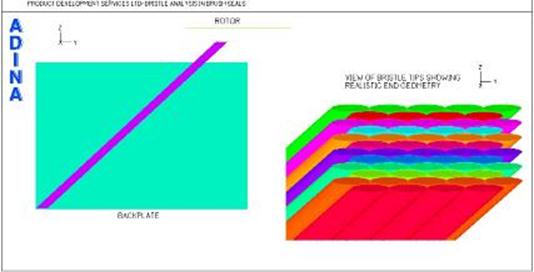
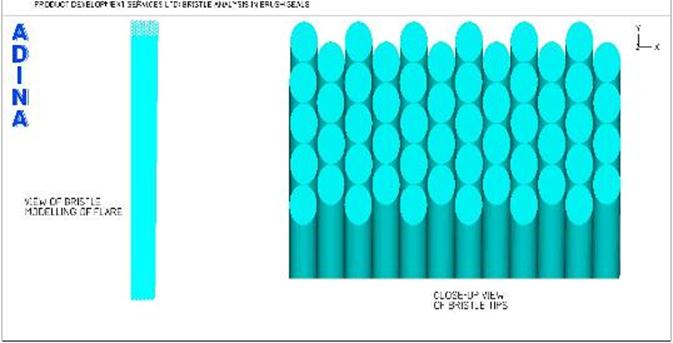
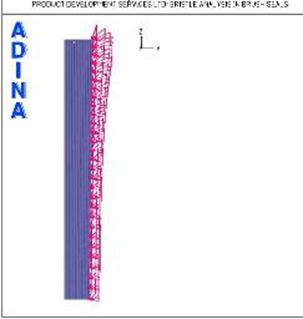
|
The left hand plot shows the overall FEA model. The Cant / Lay angle in this case is 47.25 degrees
The right hand FEA model shows a close-up of the bristle tips. It should be noted that the bristle tips have been precisely modelled. For clarity, only the bristles are shown in the right plot. |
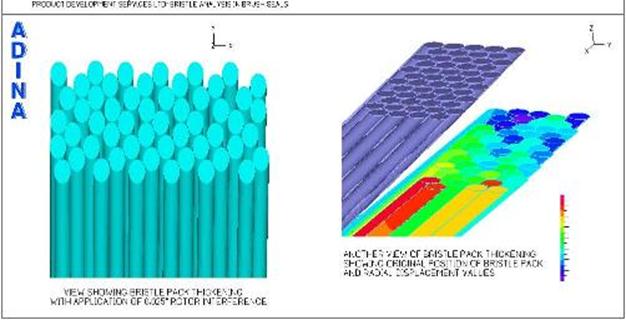
|
The axial pressure is shown here. It can be seen that this pressure varies radially. |
|
Brush Seal tip force variation hysteresis loop |
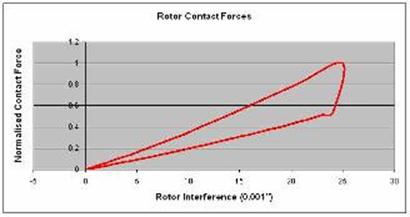
|
Blow-Down of Bristle tips resulting from a radially varying axial pressure. |
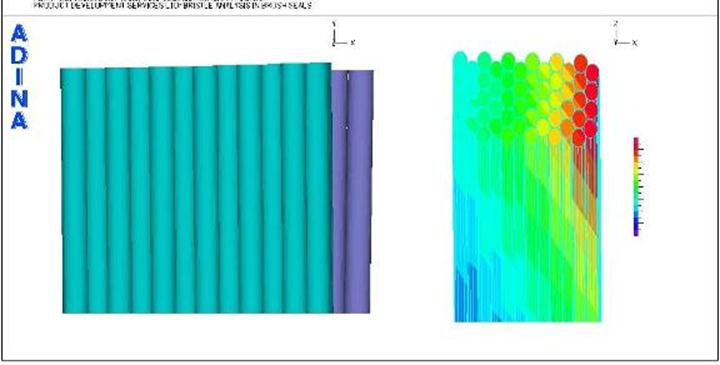
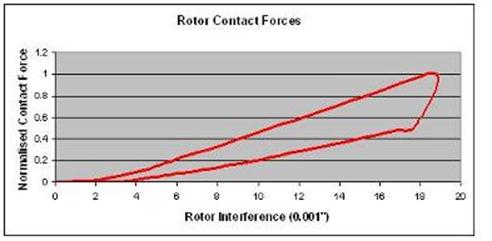
|
Brush Seal tip force variation hysteresis loop with Axial pressure stiffening effects included.
The results for two different brush seal designs are shown here. In the top graph the ‘hang up’ of the bristle pack can clearly be seen occurring at around 3.5 thou. In the bottom graph the ‘hang-up’ can be seen at around 19 thou interference. In this case an initial 1 thou interference was applied prior to the axial pressure being applied. |
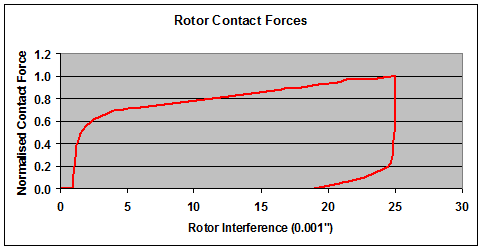
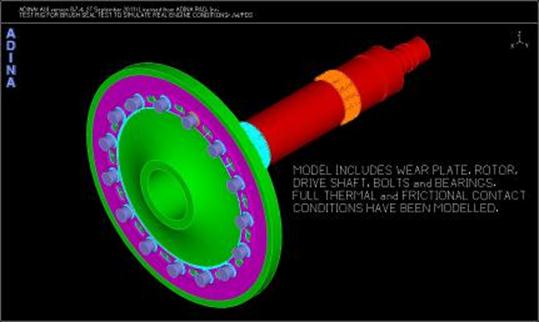
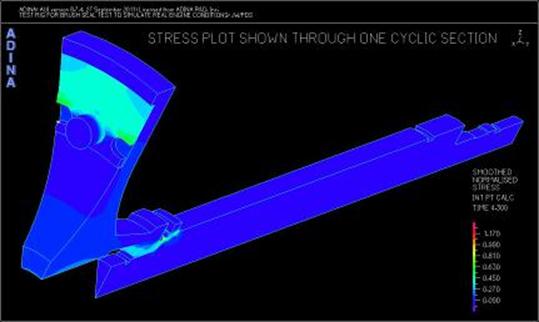
|
This test rig is used to test various Brush Seal Designs. A comprehensive and realistic 3D FEA model has been created for this analysis. The model includes Rotor, Wear Plate, Drive Shaft, Bolts and Bearings have been included in this model.
Full frictional contact conditions are included between all components.
This is a full Thermal Mechanical Coupled FEA model. Realistic Heat Transfer convection boundary conditions being modelled including variable variable Heat Transfer coefficients for all rotating parts.
Bolt elements which give accurate pre-tensioning conditions were used in this FEA model.
Consequently, the results from this FEA have been used with confidence to optimise various parameters. In particular, high rotational speeds have been achieved at high temperatures.
These results are shown courtesy of Cross Manufacturing Company (1938) Ltd. Their products are fitted as original equipment on engines manufactured by GE Aircraft Engines, Rolls Royce, Honeywell, Pratt & Whitney and MTU. |
|
Test Rig for Brush Seal Tests to Simulate Real Engine Conditions |
|
CFD Analysis of Brush Seal Bristle Pack as a Permeable Porous Medium Model |

|
Analysis of Brush Seal Design and Hydrostatic Bearing models |
|
CFD Hydrostatic Bearing Analysis |
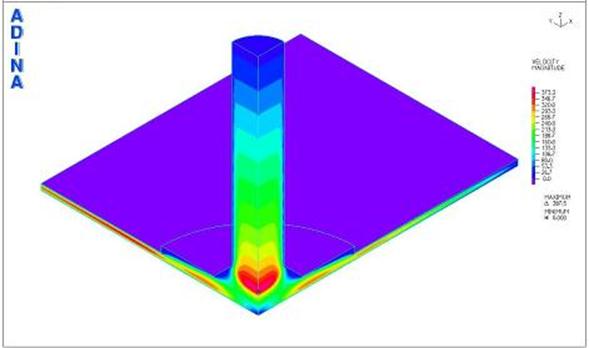
|
Hydrostatic bearings provide for the possibility of extremely long life since the bearing surfaces do not come in to contact.
The load carrying capacity primarily depends on a combination of the pressurisation distribution and geometric dimensions (not the viscosity). ADINA CFD is ideally suited to this type of work because of its very efficient high speed compressible capabilities.
This industrial case study involves a fully compressible 3D CFD analysis. The project included looking at changing several geometric parameters to determine sensitivity and optimisation of the bearing. The model produced, due to symmetry conditions, was 1/4 model . Fig 1 below shows the initial model. Figs 2 shows (from a different angle to that in Fig 1) the velocity profile. Fig 3 shows a zoomed-in view in the feed-restrictor / film area. |
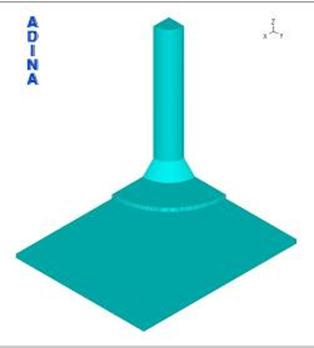
|
Fig 1 |
|
Fig 2 |
|
Fig 3 |

|
Tel: +44 (0)121 703 9236 or e-mail: info@pdslimited.com © Copyright Product Development Services Ltd. All rights reserved 2012 |
|
Brush Seal Bristle Pack FEA Analysis |
|
This compressible analysis, with thermal conditions, models the brush seal bristle pack as a porous medium with porosity and permeability values defined. It uses variable anistropic permeability conditions through the brush seal. The viscous and inertial (non-Darcian / Darcy-Forchheimer) parameters, or resistance coefficients, are modelled as variable anisotropic.
The graph on the left shows the pressure distribution along the length of each bristle row. Each curve represents one bristle row. These pressures are then applied on the structural FEA analysis (see below) to accurately model structural responses, blowdown etc.
The filled plot on the left shows the pressure distribution near the clearance area. Since thermal conditions are included, the brush seal temperature distribution analysis is performed at the same time.
The plot below shows a typical CFD mesh utilised. The different colours indicate different regions ie upstream area, brush seal, backplate and downstream area.
Different types have brush seal design (e.g. Pressure Balanced, Active and Standard) have been modelled. In addition, paramterised studies have been conducted for various lay angles, bristle diameters, bristle packing densities and bristle lengths. |

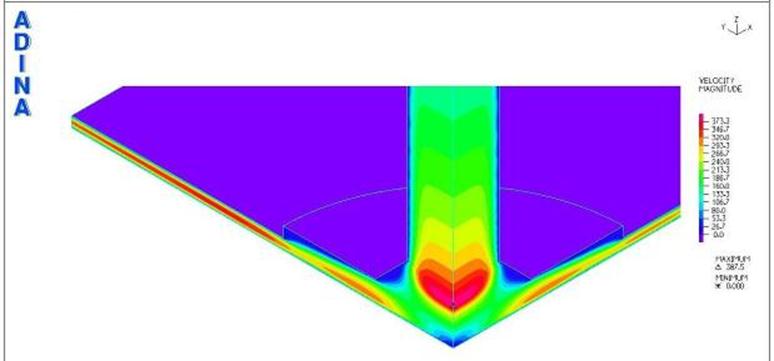
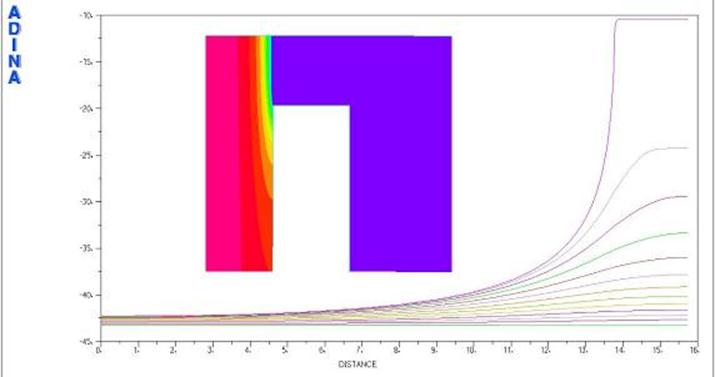
|
INDUSTRIES |
|